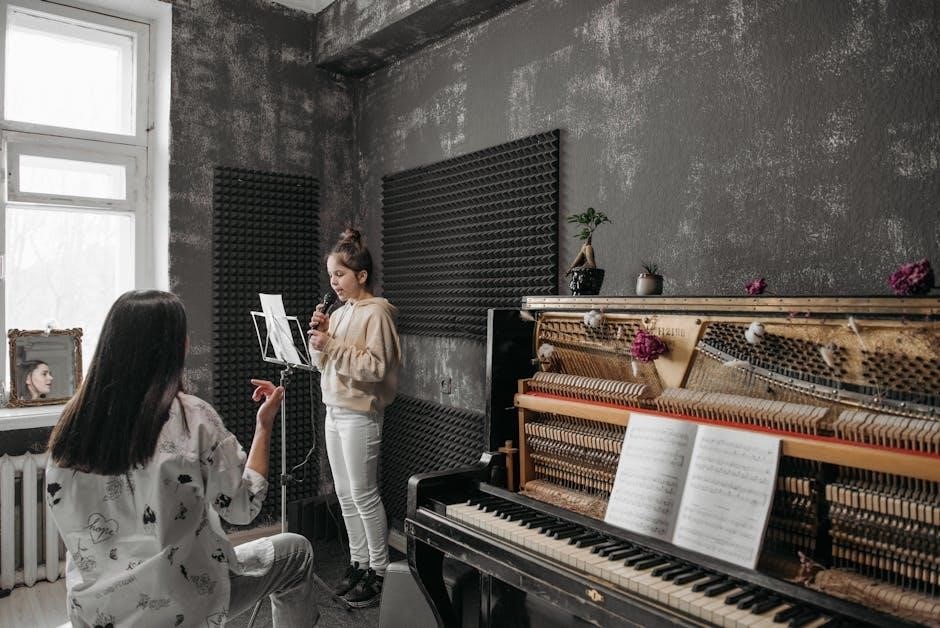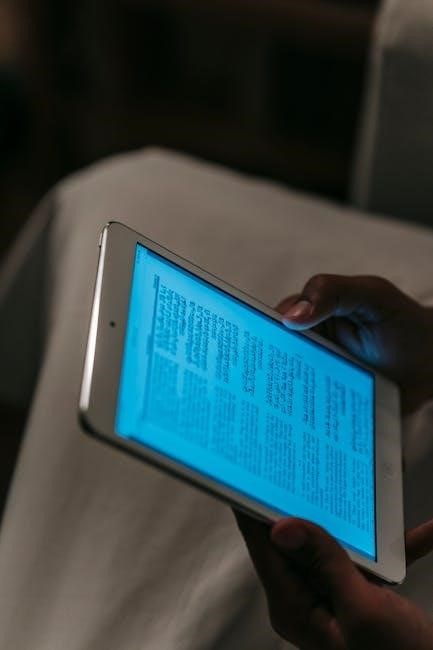Sight reading pdf piano involves playing musical scores without prior practice, using graded books and sample tests for improvement, with resources available online in pdf format easily.
Definition and Importance of Sight Reading
Sight reading is the ability to play a musical score without prior practice, and it is a crucial skill for piano players to develop. The definition of sight reading encompasses the ability to read and play musical notation accurately and efficiently. This skill is important because it allows piano players to learn new pieces quickly and to perform with confidence. Sight reading also enhances musical understanding and appreciation, as it enables players to explore a wide range of repertoire and to develop their own interpretation of the music. Furthermore, sight reading is a valuable tool for musicians, as it facilitates learning, improvisation, and collaboration with other musicians. By developing sight reading skills, piano players can improve their overall musicianship and expand their musical horizons, making it an essential part of piano study and practice, with numerous benefits for their musical development and career.
Benefits of Sight Reading for Piano Players
The benefits of sight reading for piano players are numerous and significant. Sight reading improves piano players’ ability to learn new pieces quickly, enhances their musical understanding and appreciation, and facilitates collaboration with other musicians. It also develops their critical thinking and problem-solving skills, as they need to interpret and execute the musical notation accurately. Additionally, sight reading helps piano players to develop their own unique sound and style, as they are able to explore a wide range of repertoire and interpret the music in their own way. Overall, sight reading is an essential skill for piano players, as it enables them to become more versatile, confident, and expressive musicians, with a deeper understanding of music and its many nuances, and to improve their overall performance and musicality, making it a valuable investment of time and effort for any serious piano player.

Resources for Sight Reading Practice
Graded books and online resources provide valuable materials for sight reading practice and improvement daily with pdf files and sample tests available for download easily always.
Graded Books and Sample Tests for Sight Reading
Graded books and sample tests are essential resources for sight reading practice, providing a structured approach to improvement. These materials are designed to help pianists develop their skills in a progressive manner, with each level building on the previous one. Online platforms offer a wide range of graded books and sample tests in pdf format, making it easy to access and download the necessary materials. The sample tests are particularly useful, as they allow pianists to assess their current level and identify areas for improvement. By working through these tests and graded books, pianists can develop their sight reading skills in a systematic and effective way, leading to increased confidence and proficiency at the piano. The availability of these resources has made it possible for pianists to practice sight reading regularly, leading to significant improvements in their overall musical ability.
Repertoire Books and Collections for Sight Reading
Repertoire books and collections play a vital role in sight reading practice, offering a diverse range of musical styles and genres. These books and collections are carefully curated to provide pianists with a wide range of repertoire to explore, from classical to contemporary pieces. Many online platforms offer repertoire books and collections in pdf format, making it easy to access and download the desired materials. The collections often feature works by renowned composers, as well as lesser-known pieces, allowing pianists to discover new music and expand their musical knowledge. By exploring these repertoire books and collections, pianists can develop their sight reading skills while also broadening their musical understanding and appreciation. The repertoire books and collections are an essential resource for pianists, providing a wealth of musical material to practice and perform. They are a valuable tool for sight reading practice and musical development.
Piano Sight Reading Apps and Software
Piano sight reading apps and software have revolutionized the way pianists practice and improve their sight reading skills. These digital tools offer a range of features, including interactive exercises, customizable practice sessions, and real-time feedback. Many apps and software programs provide access to a vast library of musical scores, allowing pianists to practice sight reading with a wide range of repertoire. Some popular apps and software also include features such as tempo adjustment, pitch recognition, and mistake detection, helping pianists to identify and correct errors. With the convenience of mobile devices and computers, pianists can practice sight reading anywhere and anytime, making it easier to fit practice into a busy schedule. The apps and software are designed to be user-friendly and accessible, making it easy for pianists of all levels to improve their sight reading skills and take their playing to the next level.

Techniques for Improving Sight Reading Skills
Using online resources and practice exercises improves sight reading skills quickly and efficiently every day.
Understanding Intonation and Etude in Sight Reading
Understanding intonation and etude in sight reading is crucial for piano players to develop their skills. Intonation refers to the pitch accuracy and etude refers to the practice exercises.
These concepts are essential in sight reading as they help piano players to develop their musicality and technique. By practicing etudes, piano players can improve their sight reading skills and develop their musical understanding.
Additionally, understanding intonation is vital in sight reading as it helps piano players to play with precision and accuracy. With the help of online resources and practice exercises, piano players can improve their intonation and etude skills, leading to better sight reading abilities.
Overall, understanding intonation and etude in sight reading is essential for piano players to develop their skills and become proficient in sight reading.
Developing Musicianship through Sight Reading
Developing musicianship through sight reading is a vital aspect of piano education, enhancing overall musical understanding and ability.
This process involves interpreting musical notation, recognizing patterns, and responding expressively.
By engaging in sight reading, pianists can refine their musical instincts, cultivating a deeper connection with the music.
Regular practice of sight reading can also foster improved critical thinking, analytical skills, and creativity, all essential components of musicianship.
Furthermore, sight reading enables pianists to explore a wide range of repertoire, broadening their musical knowledge and appreciation, and ultimately leading to a more nuanced and expressive performance.
Through dedicated practice and a commitment to sight reading, pianists can develop a more refined and sophisticated musical sense, elevating their overall musicianship.
Applications of Sight Reading in Music Education
Sight reading pdf piano enhances music education by improving skills and knowledge through practical applications and resources online in pdf format for easy access always available;
Using Sight Reading to Reduce Psychological Pressure
The application of sight reading in music education can be used to reduce psychological pressure on students, allowing them to focus on the music itself. By implementing sight reading exercises, students can develop a sense of calm and confidence when approaching new musical scores. This, in turn, can help to reduce anxiety and stress associated with performing in front of others. The use of sight reading pdf piano resources can also provide students with a sense of control and preparation, further reducing psychological pressure. Additionally, sight reading can help students to develop a growth mindset, focusing on the process of learning and improvement rather than the end result. Overall, the incorporation of sight reading into music education can have a positive impact on students’ mental wellbeing and performance. This approach can be particularly beneficial for students who experience performance anxiety or stress.
Integrating Sight Reading into Piano Lessons
Integrating sight reading into piano lessons can be achieved through a variety of methods, including the use of sight reading pdf piano resources. Piano teachers can incorporate sight reading exercises into their lessons, starting with simple melodies and gradually increasing the complexity. This can help students develop their sight reading skills and build confidence in their ability to play new music. Teachers can also use technology, such as piano sight reading apps and software, to provide students with interactive and engaging sight reading exercises. By incorporating sight reading into piano lessons, teachers can help students develop a range of skills, including musicality, technique, and overall musicianship. Regular sight reading practice can also help students to develop a sense of fluency and expression in their playing, allowing them to communicate the music more effectively. This approach can be tailored to meet the needs of individual students.


About the author